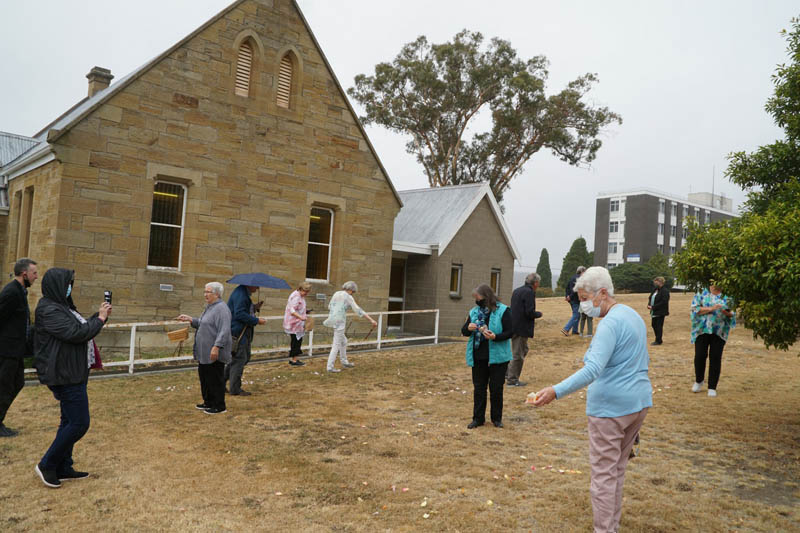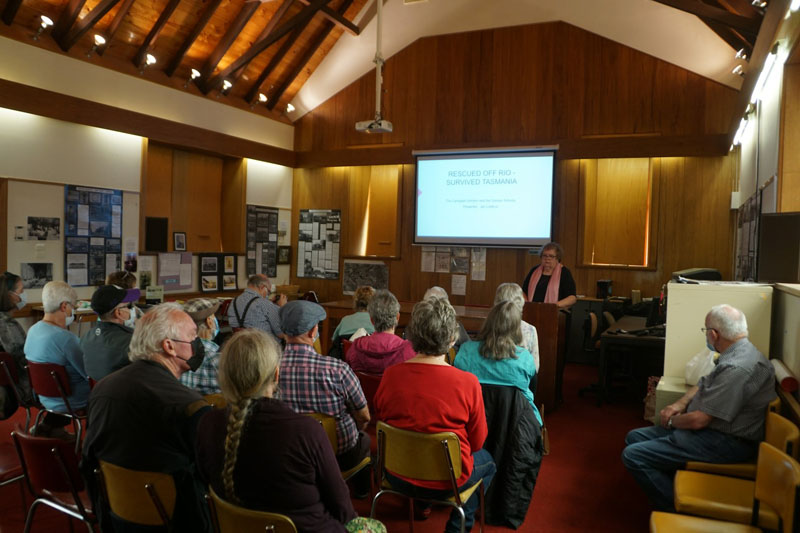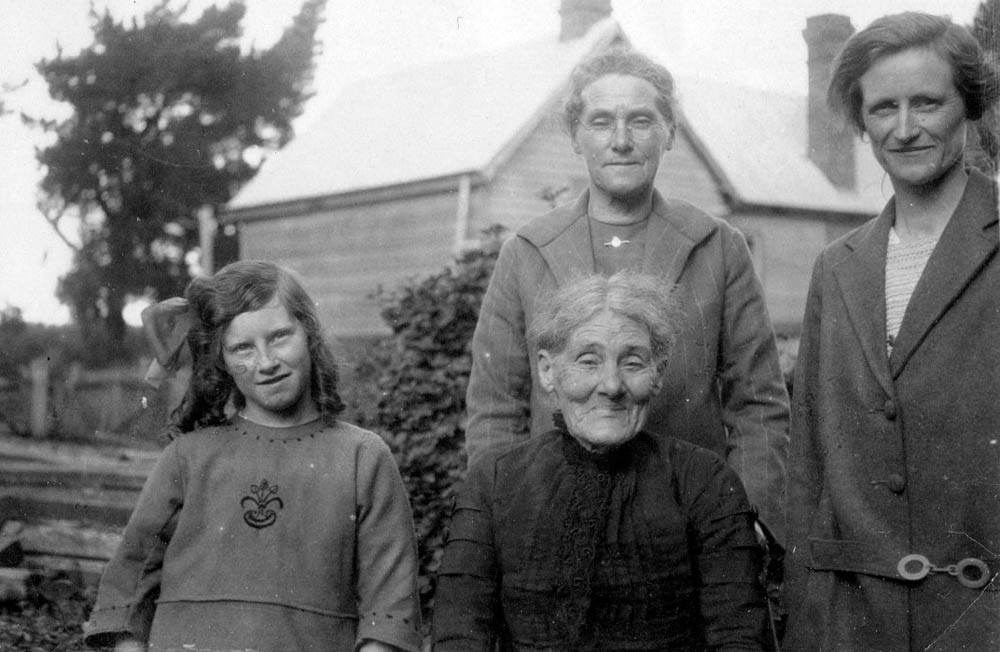
Newsletter 40 March 2022
View this email in your browser
FOX’S FEAST - 27 FEBRUARY 2022
Presentation by Jan Liddicut (Jozsa)
Edited for publication by Margaret Dalkin with suggestions from Jan.
Prior to lunch in the Old Sunday School and scattering rose petals on the grass over the unmarked graves of the children from the Orphan Schools who died whilst at the institutions, Jan Liddicut (Jozsa) who attended with her husband from Victoria, gave the thirty attendees a most engaging and well researched paper, Rescued off Rio, Survived Tasmania. Jan’s three times great grandmother Eliza Campbell with her three siblings endured more than four years at the Orphan Schools from 1833 to 1838. Their story was heartbreaking, and Jan honored their memory and the legacy these young immigrants left as pioneers of modern Australia.

Scattering rose petals on the burial ground at Fox's Feast 27 Feb 2022
I have summarized her talk using many of her own words. Some expansion into details of life at the Orphan Schools and the later life of her subjects has been omitted for publication purposes.
Jan’s acknowledgements were to the Palawa people, Eliza Campbell eight, her sister Mary Ann twelve, and their brothers James nine and Thomas five.
The Campbell children were not orphans. Their father James was from Scotland and their mother was Irish and died c. 1828. Their early life was in southern Ireland. After James remarried, they migrated to Van Diemen’s Land.
They were placed in the Orphan Schools as ‘compensation’ to their father and stepmother who lost everything en route to Hobart. They were a family of free settlers who were shipwrecked when the Hibernia, with two hundred and nine free settlers and twenty-three crew for Van Diemen’s Land sunk on the 4th of February 1833 after the ship caught fire below decks 1100 miles off the Pernambucco coast of Brazil.
The family of six were among the seventy-nine people and three squealing pigs who survived in a longboat, pinnace and small gig. The fate of the pigs can be imagined. As Adelaide Campbell was pregnant, it may have earned them special consideration.
Jan described the terror of the survivors who watched the burning ship and the people unable to be saved. They endured horrendous privations in the small boats on the open sea. The Captain and the First Mate fell out over water rations and a man died and was sent to the deep. On day seven, a passing convict ship, the Lotus, rescued the survivors in the long boat and gig.
The following day, the brig Isabella with two hundred and seventy convicts on board, rescued those in the pinnace, including the Campbell family.
All the survivors were taken to Rio De Janeiro and billeted with local ex-pats who took up a collection, while the British Consul found a ship, coincidentally named Adelaide. They left Rio on the 19th March and on the 27th, Adelaide Campbell gave birth to a son, Robert. So, when the family arrived in Hobart on the 19th of May, there were seven Campbells.
Governor Arthur immediately set up a ‘Relief Committee for the Survivors of the Hibernia to determine what help could be given and to whom.
Churches held special services and more collections were taken up for the survivors but the future of these unfortunate people, in particular the children, was in the hands of the Colonial Government.
The Campbell’s came in for special mention in the Committee’s report, which noted that the parents were in ill health and would need pecuniary aid.
The Relief Committee determined that the Campbell children and three others should be removed to the Orphan School for at least twelve months at the Committee’s expense of £6 per year for each child, or until the authorities felt their parents were able to support them.
Eliza and Mary Ann were removed from their parents on the 23rd May, four days after their ship docked in Hobart. James and Thomas were admitted later, on 23rd July and 20th November respectively. They could not leave without the Governor’s consent.
They were amongst the first cohort of children to be housed at the new King’s Orphan Schools and likely attended the grand opening ceremony in the presence of Governor Arthur. Thomas and Ann Stone were then Master and Matron.
They lived with strangers including convicted juveniles, the children of convicts, abandoned, orphaned and other destitute children, children with only one parent and aboriginal and mixed-race children.
Within a year of their arrival, James and Adelaide Campbell moved to Launceston with baby Robert. It is not known if the children saw their parents for the permitted four visits a year in the presence of the Master or Matron, or why they remained in the Orphan Schools for four and half years. In 1835, a sixth child, Harriet Campbell, was born.
Jan described life in the Orphan Schools, which is well known to those reading this article.
In response to a criticism, Rev. Naylor described the Campbell children as ‘cranky’, which in those days meant low intelligence. He also said they were unwilling to learn. As Gaelic was almost certainly their first language and would not have been considered.
Thomas was released on 8th December 1837 aged nine or ten. The following day, Eliza and Mary Ann were released and delivered to the ‘Tasman’ for transportation by sea to their parents in Launceston.
The ship’s captain was appalled at the condition of the children who were sent with only the ragged clothes they were wearing and no bedding. He admonished Reverend Naylor for failing to provide them with adequate supplies and especially, provisions suitable for young girls.
Thomas seems to have worked as a labourer and thirteen months after his release from the Orphan School, he was crushed to death when the dray of a bullock wagon laden with timber, overturned at Bridgetown.
It is not known why James left the Orphan School a year later than his siblings. He left Tasmania and returned to Ireland where he married and had a family.
In February,1838, two months after their release, the girls were working as servants. That same month, their father complained to Launceston Police that Mary Ann had been assaulted at work by another servant.
A month later, Eliza was convicted for failing to turn up to work and sentenced to two weeks in prison. But at the request of her perhaps remorseful employer (who had abused her), her sentence was commuted, and her father fined ₤5 for encouraging her to be absent.
In 1840 and less than two years after leaving the Orphan Schools, both girls were in relationships. Mary Ann married an older ticket of leave man Ephraim Fowler, who was conditionally pardoned in 1842. That year, she gave birth to her first child and five months later, Ephraim died suddenly from convulsions and a heart attack. As she was suspected of poisoning him, Mary Ann had to detail everything preceding Ephraim’s death to an inquest panel. As she also ate the suspect pie and had witness support, she was cleared of involvement. Some months later, Mary Ann married convict William Maumill with whom she had seven children. He became a landowner and Mary Ann’s life improved. She died at Sidmouth in 1893 aged about seventy-one.
Eliza formed a relationship with convict William Reynolds in 1839. He arrived in Hobart in 1830 having left a distraught young wife and a loving mother in England. The love token he left his wife, is now in the National Museum of Australia in Canberra. The heartbreaking message was “Farewell to all but not forever”.
In July 1840, fifteen-year-old Eliza gave birth to their first child, but the baby died six months later. In 1841, she and William married at Westbury police station and went on to have another four daughters and one son, all of whom survived. Jan displayed a beautiful photograph of the four Reynolds sisters.
William was pardoned in 1854 and became a moderately successful tailor in Hobart. In his daughter Jane’s obituary in the Hobart Mercury in 1934, William was described as a “master tailor” with no mention of his convict history.
Eliza died in Hobart in 1863 of a malignancy. The location of her grave in St David’s cemetery is not known.
Jan is a descendant of Eliza and William’s eldest surviving child, Ann, who was determined to improve her life and achieve respectability. She left Tasmania for Victoria aged twenty-two and married a Ballarat butcher.
The new sculptures of two Orphan School children by Irish sculptor Rowan Gillespie are immediately across the road from land where another branch of Jan’s family farmed from 1821. So, Jan feels a special connection with the St John’s Park Precinct, it’s history and ongoing custodianship. She is a proud descendant of humble, ordinary people who survived extraordinary and terrible ordeals.

Presentation by Jan Liddicut (Jozsa) at Fox's Feast 27 Feb 2022
Above photos courtesy of Bruce Woods 2022
Agnes Hay – Her Story
Jane Hodgman- a great-great-granddaughter
The old lady in the photograph is my great-great-grandmother Agnes Hay. She is seen here with her daughter, grand-daughter and great-grand daughter. The photograph was possibly taken in Devonport in the 1930s where she died in 1937 aged eighty-five.

I suspect that Agnes’ family knew little of her story which began in Edinburgh in 1848. Her parents were Matthew Hay, a blacksmith and Margaret Erskine, daughter of a spirit dealer.
By 1851, Margaret now a widow, was convicted of stealing boots and shoes and was transported with her four-year-old daughter Agnes and ten-month-old baby Margaret.
The little family arrived in Hobart on the 26th of January 1852 on the convict ship Anna Maria and were sent to the Cascades Female Factory.
In March, Agnes’ baby sister Margaret died, and Margaret Erskine aka Hay was assigned to a Mr McTavish in New Town Road. Not long after that, Agnes was admitted to the Queen’s Orphan School.
Having absconded several times and spending five days in the cells back at the Cascades Female Factory, later in 1852 Margaret was assigned to the Rev T. J. Ewing, the clergyman and headmaster at the Queen’s Orphan Schools. I would like to think that this meant she managed to have some contact with little Agnes.
In January 1853, a year and a day after arriving in Hobart, Margaret married Richard Wilson in St John’s church. They were married by the Rev. Ewing and nine months later baby Richard Wilson was born. In March 1854, Agnes was discharged into her mother’s care.
Unfortunately, the marriage was not one made in Heaven as portrayed in an article in the Colonial Times where Richard was described as;
a shocking specimen of a drunkard,
and that Margaret;
had been obliged to leave him and go into service, in consequence of her husband’s ill-usage . [1]
In October 1856 Agnes now eight and a half, and three-year-old Richard were admitted into the care of the Queen’s Orphan Schools. They may have had little contact with each other as girls and boys were separated, but as Richard was still a toddler, he may have been housed in the Girls’ School under the care of older girls.
Sadly, Richard died from whooping cough in December 1858, aged only five years. He was laid to rest in the burial ground at St John’s where children who died whilst in the care of the Orphan Schools were interred.
Six years later, in July 1862, now aged fourteen, Agnes was apprenticed, or given into service, to pastoralist and colonial artist Robert Beauchamp in Launceston.
Her apprenticeship expired in 1866 when she was eighteen.
Two years later in February 1868, a baby daughter, Martha was born to Agnes Hayes (sic) and “Smith”. My grandfather would have been mortified had he known his mother (a staunch Salvation Army officer) was illegitimate!
Agnes must have struggled to support her little girl, as in January 1869 she appeared before the magistrate accused of;
unlawfully leaving her infant child without any means of support from the first of November last. [2]
In June 1871, Agnes, a “servant” married “labourer” Frederick Curner a forty-year-old ex-convict in Latrobe. They had four children together, but none survived into adulthood. After seven children, Agnes’ only surviving child was her illegitimate daughter Martha, my great-grandmother.
By 1890, Agnes was a widow, Frederick having died after surgery to remove his leg at the hip. She lived at Frogmore, near Latrobe in a one roomed hut and in 1921 made the papers again when the Launceston Examiner reported that;
George Saunders, an old resident of Latrobe, was found dead in his cottage in James Street about 10 o’clock on Friday morning by Mrs Agnes Curner, who had been in the habit of going to read the morning paper to him. When Mrs Curner called to him and received no reply she went in and found Saunders lying on the floor fully dressed…. [3]
Agnes’ education at the Queen’s Orphan School gave her useful skills to help others.
Eventually, Agnes moved into an aged care facility in Devonport where she died in 1937.
Agnes lives on through Martha’s descendants who live throughout Australia and overseas. One great-great granddaughter married the grandson of Joseph Lyons, Tasmania’s only Prime Minister.
I am a proud descendant of this little Orphan School resident who showed tremendous strength, resilience, and compassion in her long life.
[1] Colonial Times 22 July 1856 p.2.
[2] Cornwall Chronicle 6 January 1869 p.5.[3] Launceston Examiner 18 June 1921 p.6.
Tours
If you or a group would like a guided tour of the St John's Park Precinct, please express interest here:
The Orphan Schools 1828-2023: remembering 195 years
If you would like to contribute a chapter to the proposed Friends of the Orphan Schools publication marking 195 years since the establishment of the first Orphan Schools in Van Diemen’s Land, please send a short abstract (100-150 words) outlining the chapter you wish to submit for consideration. The deadline for submission of abstracts is 30 April 2022.
Kind regards
Dianne Snowden,
President, Friends of the Orphan Schools Inc.
Request for items
If you have a short article or item of interest you think would be suitable for the Newsletter, your contribution is welcomed. Please email the Editor, Margaret Dalkin.
2022 contributions for the Newsletter due:
1 May 2022
1 August 2022
1 November 2022
Editor: Margaret Dalkin
Publishing: Andrew Cocker
Contact Us
Friends of The Orphan Schools
PO Box 4659
Bathurst Street PO
HOBART TAS 7000